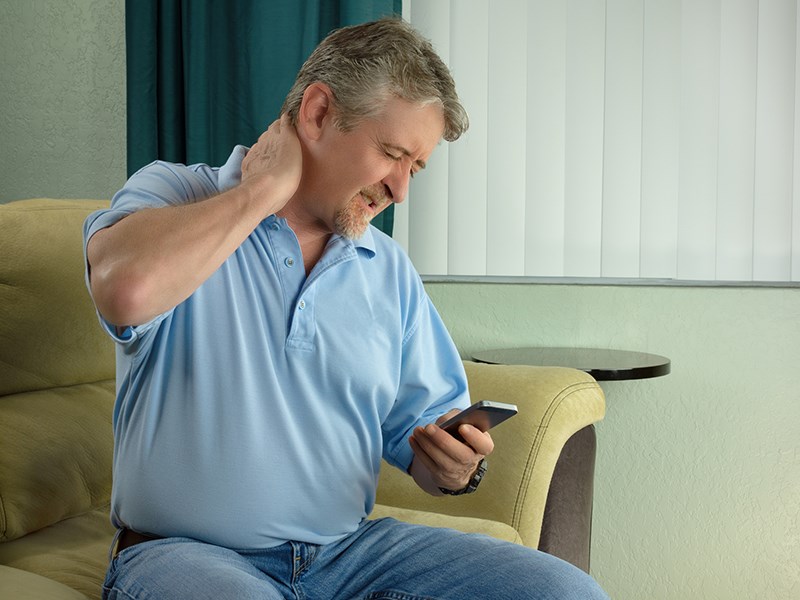Have you heard of text neck? Most of us have at least a mobile phone, if not also a tablet or e-reader. And many of us spend a great deal of time looking down at these devices.
Text neck is another name for anterior head syndrome, and it’s something that can arise from prolonged staring down at phones or tablets. The position is head forward and tilted, shoulders rounded, and back slumped or hunched, often paired with a lack of core activation.
If you notice you have a nagging pain in the neck or shoulders, perhaps made worse when using a mobile device, general shoulder tightness, or headaches that are made worse by looking down, you may be suffering from text neck.
This tilted head position puts more stress on the cervical spine, since the further forward or tilted your head is, the greater the load the neck has to carry. This can lead to the compression and tightening of the front of the neck, and the lengthening of the back of the neck.
Constantly putting your body in this position can lead to inflammation of the neck ligaments, nerve irritation and an increased curvature in the spine. It can also develop into an upper thoracic postural deformity known as dowager’s hump, which can result in the alteration of the bone structure of your vertebrae.
Now that I’ve scared you like googling your symptoms or checking WebMD, let’s talk about what we can do about it.
First and foremost, if you have a serious issue, seek professional medical advice. But if you are just a little sore, you can try the exercises below, perhaps paired with a regular strength and stretching routine, and see if they help to alleviate some discomfort.
Beyond doing the exercises, some of the best things you can do include taking breaks, or changing the level or position of your phone to eye level.
Exaggerated nod
The exaggerated nod will help with neck mobility. Look up to the ceiling. Pause. Relax your jaw and open your mouth. This should allow your head to tilt back a little further. Then close your mouth and you’ll feel a stretch through the front of the neck. Do this exercise two to three times.
Downward facing dog
Shoulder scrunching often happens if we don’t have enough upper body strength. Downward facing dog can help, but it’s also a great gentle inversion. Start from tabletop, on your hands and knees, with knees under your hips and hands under your shoulders. Raise your knees off the mat, lifting your hips high, while bringing your belly toward your thighs. As your legs straighten, keep your toes pointing forward. Your ears should be beside your biceps, with the eyes of the elbows looking forward. Hold the position for three breaths, take a short break and come into the position again two more times.
Forward fold
This is a great position to stretch your neck and hamstrings, relieving some of the tightness in the hips from excessive sitting. Exhale as you bend forward at the hips, letting the crown of your head hang down, reaching your hands down to the ground, with the hips coming high. You can have blocks or another item for your hands to rest on if you have trouble reaching the floor and/or find the stretch too intense or feel excessive rounding in the back. Hold this position for three breaths, gently come out by slowly rolling up one vertebrae at a time, ensuring you are activating your belly to help with the lift.
Chin tuck
The chin tuck can increase spinal awareness while strengthening the neck muscles. It helps to pull the head back into alignment. With your chin parallel to the floor, and without tilting your head, draw your head back like you’re making a double chin. Do this exercise two to three times.
Shoulder blade pinches
This helps to create some awareness of the relationship between the chest and back, and helps us to remember not to slouch and round forward. Standing tall (or seated) draw your shoulder blades together, like you want the bones to pinch something in between them. Do four to six, take a break and do another couple rounds. Remember to draw the shoulder down as you do it.
Melissa Sloos is a certified group fitness instructor, spin instructor and co-owner at Coast Fitness in Powell River.



